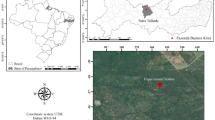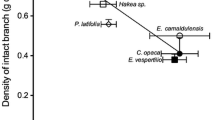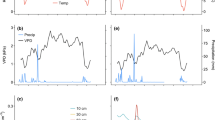Abstract
Key message
In tropical forests, co-occurring woody monocot and dicot species adapted different water use strategies highly depending on their investment in the hydraulic conduit properties.
Abstract
We studied the hydraulic efficiency of palms and broad-leaved tropical tree species from a moist tropical lowland forest in the Central Brazilian Amazon. Therefore, we harvested 34 trees and 10 açai palms and measured vessel size and frequency at diameter at breast height and additionally at the base of the crown shaft for the palms. Further, we assessed the active xylem area to estimate the hydraulic conductivity through Hagen Poiseuille’s adapted theoretical equation. Mean vessel diameter in dicot trees was 127.62 ± 49.22 μm with an average 9.09 ± 6.50 vessels per mm2. Mean conduits sizes at the base (h = 0.10 m) of palm trees were larger with 288.20 ± 32.96 μm and less frequent with 1.40 ± 0.46 vessels per mm2. Hydraulic conductivity was on average 3.31 ± 4.59 kg m−1 s−1 MPa−1 for dicot trees. Mean hydraulic conductivity in açai palms was 20.45 ± 10.6 kg m−1 s−1 MPa−1 at the base, and increased to 124.73 ± 55.2 kg m−1 s−1 MPa−1 at the crown base. Hydraulic conductivity at the base of the crown was higher than in the base of the trunk due to the high density of vessels in a small cross-section in this height. Furthermore, we found a species-independent relationship between vessel diameter and frequency. We conclude that the differences found in the hydraulic efficiency give some evidence that palms have a lower occurrence of embolism and cavitation than trees, which is due to stiffer and stronger conduit pathways and efficient drought-avoiding strategies. The differences in hydraulic architecture between palms and trees imply different water use patterns thus varying niche differentiation, but this does not consequently need to be an excluding factor for coexistence in the same environment.



Similar content being viewed by others
References
Barusso AP (1977) Determinação de funções de crescimento mediante análise de tronco. Dissertation, Universidade Federal do Paraná, not defended
Bravard S, Righi D (1989) Geochemical differences in an Oxisol-Spodosol toposequence of Amazonia, Brazil. Geoderma 44:29–42
Castilho CV, Magnusson WE, Araujo RNO, Luizao RCC, Luizao FJ, Lima AP, Higuchi N (2006) Variation in aboveground tree live biomass in a central Amazonian Forest: effects of soil and topography. For Ecol Manag 234:85–96
COPANT—Comission Panamericana de Normas Técnicas (1974) Descripcion de características generales, macroscópicas de las maderas angiospermas dicotiledoneas. COPANT 30:1–19
Cruiziat P, Cochard H, Améglio T (2002) Hydraulic architecture of trees: main concepts and results. Ann For Sci 59:723–752
da Silva F, Suwa R, Kajimoto T, Ishizuka M, Higuchi N, Kunert N (2015) Allometric equations for estimating biomass of Euterpe precatoria, the most abundant palm species in the Amazon. Forests 6:450–463
Davies J, Burke D, Olliver JR, Hardie LJ, Wild CP, Routledge MN (2007) Methylene blue but not indigo carmine causes DNA damage to colonocytes in vitro and in vivo at concentrations used in clinical chromoendoscopy. Gut 56:155–156
Dettmann S, Perez CA, Thomas FM (2013) Xylem anatomy and calculated hydraulic conductance of four Nothofagus species with contrasting distribution in South-Central Chile. Trees 27:685–696
Domec JC, Gartner BL (2003) Relationship between growth rates and xylem hydraulic characteristics in young, mature and old-growth ponderosa pine trees. Plant Cell Environ 26:471–483
Ewers FW, Fisher JB (1989) Techniques for measuring vessel lengths and diameters in stems of woody plants. Am J Bot 76:645–656
Fan ZX, Zhang SB, Hao GY, Slik JWF, Cao KF (2012) Hydraulic conductivity traits predict growth rates and adult stature of 40 Asian tropical tree species better than wood density. J Ecol 100:732–741
Freitas JA, Vasconcellos FJ (2010) Manual de identificação prática de madeiras comerciais da Amazônia: método macroscópico de comparação. MCT-INPA, Manaus
Gebauer T, Horna V, Leuschner C (2008) Variability in radial sap flux density patterns and sapwood area among seven co-occurring temperate broad-leaved tree species. Tree Physiol 28:1821–1830
Gomes FP, Prado CHBA (2007) Ecophysiology of coconut palm under water stress. Braz J Plant Physiol 19:377–391
Guillaumet JL (1987) Some structural and floristic aspects of the forest. Experientia 43:241–250
Hacke UG, Sperry JS, Wheeler JK, Castro L (2006) Scaling of angiosperm xylem structure with safety and efficiency. Tree Physiol 26:689–701
Henderson A, Galeano GA (1996) Euterpe, Prestoea, and Neonicholsonia (Palmae). Flora Neotropica 72:1–89
Henderson A, Galeano G, Bernal R (1995) Field guide to the palms of americas. Princeton University Press, New Jersey
Huang YS, Chen SS, Lin TP, Chen YS (2002) Growth strain in coconut palm trees. Tree Physiol 22:261–266
Johansen DA (1940) Plant microtechnique. McGraw-Hill, New York
Kitin P, Voelker SL, Meinzer FC, Beeckman H, Strauss SH, Lachenbruch B (2010) Tyloses and phenolic deposits in xylem vessels impede water transport in low-lignin transgenic poplars: a study by cryo-fluorescence microscopy. Plant Physiol 154:878–898
Kunert N, Barros P, Higuchi N (2013) Do palm water use characteristics explain the spatial distribution of palms in the Central Amazon? Acta Horticulturae 991:197–204
Lima PL, Lima OP, Magnusson WE, Higuchi N, Reis FQ (2002) Regeneration of five commercially valuable tree species after experimental logging in the Amazonian Forest. Revista Árvore 26:567–571
Lorenzi H (1992) Árvores brasileiras: Manual de identificação e cultivo de plantas arbóreas nativas do Brasil. Plantarum, Nova Odessa
Lorenzi H, Bacher L, Lacerida M, Sartori S (2006) Frutas Brasileiras e Exóticas Cultivadas (de consumo in natura). Plantarum, Nova Odessa
Maranho AS, Paiva AV (2012) Emergência de plântulas de Pourouma guianensis Aubl. (Urticaceae) em função do substrato. Revista Brasileira de Ciências Agrícolas 7:844–849
McClain ME, Richey JE, Brandes JA, Pimentel T (1997) Dissolved organic matter and terrestrial-lotic linkages in the central Amazon basin of Brazil. Global Biogeochem Cycles 11:295–311
McCulloh K, Sperry JS, Lachenbruch B, Meinzer FC, Reich PB, Voelker S (2010) Moving water well: comparing hydraulic efficiency in twigs and trunks of coniferous, ring-porous, and diffuse-porous saplings from temperate and tropical forests. New Phytol 186:439–450
McCulloh KA, Meinzer FC, Sperry JS, Lachenbruch B, Voelker SL, Woodruff DR, Domec JC (2011) Comparative hydraulic architecture of tropical tree species representing a range of successional stages and wood density. Oecologia 167:27–37
Meinzer FC, Bond BJ, Warren JM, Woodruff DR (2005) Does water transport scale universally with tree size? Funct Ecol 19:558–565
Meinzer FC, McCulloh KA, Lachenbruch B, Woodruff DR, Johnson DM (2010) The blind men and the elephant: the impact of context and scale in evaluating conflicts between plant hydraulic safety and efficiency. Oecologia 164:287–296
Mota MR, Medeiros CM (2002) Balanço Hídrico na Região de Manaus—AM. Revista da Universidade do Amazonas 10:73–78
Mulkey SS, Chazdon RL, Smith AP (1996) Tropical forest plant ecophysiology. Chapman and Hall, London
Murray CD (1926) The physiological principle of minimum work. I. The vascular system and the cost of blood volume. Proc Natl Acad Sci USA 12:207–214
Oliveira AN, Amaral IL (2004) Florística e fitossologia de uma floresta de vertente na Amazônia Central, Amazonas, Brasil. Acta Amazonica 34:21–34
Oliveira AA, Daly DC (1999) Geographic distribution of tree species occurring in the region of Manaus, Brazil: implications for regional diversity and conservation. Biodivers Conserv 8:1245–1259
Perry S (1991) Monocots and dicots. J Arboric 17:55
Pitman N, Terborgh JW, Silman MR, Nuñez VP, Neill DA, Ceron CE, Palacios WA, Aulestia M (2001) Dominance and distribution of tree species in upper Amazonian terra firme forests. Ecology 82:2101–2117
Poorter L, McDonald I, Alarcon A, Fichtler E, Licona JC, Peña-Claros M, Sterck F, Villegas Z, Sass-Klaassen U (2010) The importance of wood traits and hydraulic conductance for the performance and life history strategies of 42 rainforest tree species. New Phytol 185:481–492
Porto ML, Longhi HM, Citadini V, Ramos RJ, Madmath JEA (1976) Levantamento fitossocio16gico de ‘mata-de-baixo’ na Estação Experimental de Sivilcultura Tropical, INPA, Manaus. Acta Amazonica 6:301–318
R Core Team (2013) R: a language and environment for statistical computing. R Foundation for Statistical Computing, Vienna, Austria. http://www.R-project.org/
Renninger HJ (2010) Hydraulic costs of increasing height in palms. Dissertation, Boston University
Renninger HJ, Phillips N (2010) Intrinsic and extrinsic hydraulic factors in varying sizes of two Amazonian palms species (Iriartea deltoidea and Mauritia flexuosa) differing in development and growing environment. Am J Bot 97:1926–1936
Renninger HJ, McCulloh KA, Phillips NA (2013) Comparison of the hydraulic efficiency of a palm species (Iriartea deltoidea) with other wood types. Tree Physiol 33:152–160
Reyes-Acosta JL, Maurits W, Vandegehuchte KS, Maciek WL (2012) Novel, cyclic heat dissipation method for the correction of natural temperature gradients in sap flow measurements. Part 2 Laboratory validation. Tree Physiol 32:894–912
Ribeiro JELS et al (1999) Flora da reserva Ducke: guia de identificação das plantas vasculares de uma floresta de terra-firme na Amazônica Central. DFIC-INPA, Manaus
Rich PM (1987) Developmental anatomy of the stem of Welfia georgii, Iriartea gigantea, and other arborescent palms: implications for mechanical support. Am J Bot 74:792–802
Rosner S, Klein A, Muller U, Karlsson B (2008) Tradeoffs between hydraulic and mechanical stress responses of mature Norway spruce trunk wood. Tree Physiol 8:1179–1188
Rüggeberg M, Speck T, Paris O, Lapierre C, Pollet B, Koch G, Burgert I (2008) Stiffness gradients in vascular bundles of the palm Washingtonia robusta. Proc R Soc 275:2221–2229
Ruiz RR, Alencar JC (2004) Comportamento fenológico da palmeira patauá (Oenocarpus bataua) na reserva florestal Adolpho Ducke, Manaus, Amazonas, Brasil. Acta Amazonica 34:553–558
Salm R, Jalles-Filho E, Schuck-Paim C (2005) A model for the importance of large arborescent palms in the dynamics of seasonally-dry Amazonian forests. Biota Neotropica 5:1–6
Sano Y, Okamura Y, Utsumi Y (2005) Visualizing water-conduction pathways of living trees: selection of dyes and tissue preparation methods. Tree Physiol 25:269–275
Simonin K, Kolb TE, Montes-Helu M, Koch GW (2006) Restoration thinning and influence of tree size and leaf area to sapwood area ratio on water relations of Pinus ponderosa. Tree Physiol 26:493–503
Sperry JS (1985) Xylem embolism in the palm Rhapis excelsa. IAWA Bulletin (n.s.) 6:283–292
Sperry JS (1986) Relationship of xylem pressure potential, stomatal closure, and shoot morphology in the palm Rhapis excelsa. Plant Physiol 80:110–116
Sperry JS, Meinzer FC, McCulloh KA (2008) Safety and efficiency conflicts in hydraulic architecture: scaling from tissues to trees. Plant Cell Environ 31:632–645
Steege H et al (2013) Hyperdominance in the Amazonian tree flora. Science 342:325–334
Tomlinson PB (1979) Systematics and ecology of the Palmae. Annu Rev Ecol Sys 10:85–107
Tomlinson PB (2006) The uniqueness of palms. Bot J Linn Soc 151:5–14
Tyree MT, Ewers FW (1991) Tansley review no. 34: the hydraulic architecture of trees and other woody plants. New Phytol 119:345–360
Tyree MT, Zimmermann MH (1983) Xylem structure and the ascent of sap. Springer, New York
Tyree MT, Snyderman DA, Wilmot TR, Machado JL (1991) Water relations and hydraulic architecture of a tropical tree (Schefflera morototoni). Plant Physiol 96:1105–1113
Tyree MT, Alexander J, Machado JL (1992) Loss of hydraulic conductivity due to water stress in intact juveniles of Quercus rubra and Populus deltoides. Tree Physiol 10:411–415
Umebayashi T, Utsumi Y, Koga S, Inoue S, Shiiba Y, Arakawa K, Matsumura J, Oda K (2007) Optimal conditions for visualizing water-conducting pathways in a living tree by the dye injection method. Tree Physiol 27:993–999
Vinya R, Malhi Y, Brown N, Fisher JB (2012) Functional coordination between branch hydraulic properties and leaf functional traits in miombo woodlands: implications for water stress management and species habitat preference. Acta Physiol Plant 34:1701–1710
Vormisto J, Svenning J, Hall P, Balslev H (2004) Diversity and dominance in palm (Arecaceae) communities in terra firme forests in the western Amazon basin. J Ecol 92:577–588
Wagner F, Rossi V, Stahl C, Bonal D, Herault B (2012) Water availability is the main climate driver of Neotropical trees. PLoS One. doi:10.1371/journal.pone.0034074
Waterhouse FLS, Quinn CJ (1978) Growth patterns in the stem of the palm Archontophoenix cunninghamiana. Bot J Linn Soc 77:73–93
Wullschleger SD, Norby RJ (2001) Sap velocity and canopy transpiration in a sweetgum stand exposed to free-air CO2 enrichment (FACE). New Phytol 150:489–498
Zach A, Schuldt B, Brix S, Horna V, Culmsee H, Leuschner C (2010) Vessel diameter and xylem hydraulic conductivity increase with tree height in tropical rainforest trees in Sulawesi, Indonesia. Flora 205:506–512
Zanne AE, Westoby M, Falster DS, Ackerly DD, Loarie SR, Arnold SEJ, Coomes DA (2010) Angiosperm wood structure: global patterns in vessel anatomy and their relationship to wood density and potential conductivity. Am J Bot 97:207–215
Zimmermann MH (1983) Xylem structure and the ascent of sap. Springer, Berlin
Acknowledgments
We would like to thank CAPES (Coordination for the Improvement of Higher Level Personal) for financing the first author’s master program, CNPq (National Council for Scientific and Technological Development) for their program INCT—Madeiras da Amazônia that provides financial support for Forest Management Laboratory and ZF-2 camp site infra-structure, and INPA/CFT (Brazilian National Institute for Research in the Amazon/Tropical Forest Science Department) for their infra-structure, faculty and staff and for choosing and giving the first author the title of MSc. This present manuscript is based on partial data from the first author’s master thesis. We would also like to thank all the manual operations done by the workers at Forest Management ZF-2 camp site. Many thanks to Fernando Silva and Rempei Suwa for the palm tree harvesting. Further, we would like to thank Jorge Freitas, Francisco José Vasconcellos (INPA Xylotheque) and Claudete Catanhede do Nascimento (INPA Laboratory of Wood Artifacts Engineering) for giving access to laboratory equipment and facilitating the wood anatomy analyses.
Conflict of interest
The authors declare that they have no conflict of interest.
Author information
Authors and Affiliations
Corresponding author
Additional information
Communicated by M. Zwieniecki.
Rights and permissions
About this article
Cite this article
Aparecido, L.M.T., dos Santos, J., Higuchi, N. et al. Ecological applications of differences in the hydraulic efficiency of palms and broad-leaved trees. Trees 29, 1431–1445 (2015). https://doi.org/10.1007/s00468-015-1223-2
Received:
Revised:
Accepted:
Published:
Issue Date:
DOI: https://doi.org/10.1007/s00468-015-1223-2




